Steps to prepare for installing Windows Server 2008
With Windows Server 2008, this is the best time to start the installation and learn about the installation of 2008, as well as the necessary executable functions (such as roles and other features), analyze new installation options. Available with 2008 as Core Server installation, using Windows Deployment Services (WDS) as well as other installations, upgrades or dual boot scripts. This article will cover the basics of installing a complete copy of Windows Server 2008 in enterprise class server hardware.
With Windows Server 2008, you will see some new tools in deploying your server. With Windows Server 2008, you'll find that it's not only easy to install Windows servers, but also that there are many options that suit your needs in the production environment and what you can install (or not install). you want . For example, if you want to choose to install a server with a minimum set of necessary services, you can select the Server Core option during the installation. If you want to deploy Windows Server 2008 with a certain answer file (not intended), you have many options and features, which make deployment easier.
In this article we will introduce the basic installation options available when deploying a complete copy of Windows Server 2008 on an enterprise class server. The goal of this article is to help you adapt and understand the process of deploying Windows Server 2008 on systems in a production environment.
Note :
Keep in mind that although Windows Server 2008 is a product with many new features and improved functions, there has never been a beta or test run in production. It is not supported and is not yet a finished product. In addition, you should never introduce any new operating system (or run upgrades) in your production system or network without testing before the official lab release to ensure that applications applications and drivers as well as compatible hardware.
The task of preparation
The first step in deploying Windows Server 2008 systems is to perform all the necessary analysis for the right size for your server hardware and prepare for the most convenient installation. It's really too much to talk about the initial steps in planning the installation and the introduction here is not enough, but you need to make sure that you have all the necessary software, the right driver . Create one. Checklist or some list form to help you check what is needed to perform and what steps have been taken. This is a very useful way for problems that can be encountered during the installation process - you can quickly identify the cause of the problem when you have a follow-up checklist to repeat your steps. Always plan ahead of any deployment (big or small) and run through tests to understand what is done and what is not before installing new systems in the network or upgrading systems old. Another example, when we first started working with Windows Server 2008 in its latest forms (Longhorn) for testing purposes, you will discover that installing the enterprise class server It is really difficult due to the fact that most enterprise server hardware vendors have not yet created new releases for Windows Server 2008 and especially Windows Server 2003 drivers will not work on the latest version of Windows Server 2008.
One of the biggest problems when testing Windows Server 2008 is its incompatible RAID drivers that make installation complete but lack support and will stop the ability to continue testing. Some ways to overcome this problem are 'instance' virtualization technology, although this will not match anyone's schedule and deployment needs, so testing on the enterprise class device becomes It is very important in our plans. Planning to deploy when working with an enterprise class server is also important, not planning will cause a lot of time in solving problems that occur (such as searching for The driver has been updated). When working with the device, it is generally advisable to work directly with support groups to get a new development driver that supports Windows Server 2008.
So why is there so much debate about the system - or so-called 'business class' system? Simply, most data centers run their systems on enterprise class hardware, not PC hardware. An enterprise class server is a system built for large networks and is often very powerful, scalable and redundant. Although the prices of the systems are much more expensive, it gives you more functionality and flexibility when deploying and is easy to fix when problems arise - servers even have can still run without interruption while defective components are replaced or repaired.
Enterprise class servers can be extended to meet the requirements for enterprise class applications, such as SQL Server, Exchange, and application platforms. An enterprise server often has high hardware components, most of these server systems (such as Dell, HP, IBM, etc.) have a set of genuine software tools, these tools are used to install drivers and management software in Windows so that Windows can work with enterprise class hardware. An example of an enterprise layer system HP DL380 is shown in Figure 1 below.
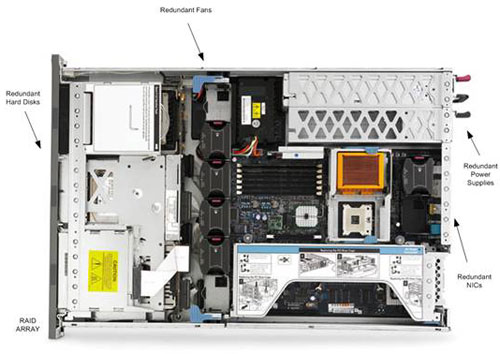
Figure 1: An enterprise class server system
In Figure 1, you can see that not most hardware installed on the server is redundant. Redundant, 2 CPU Slots (one has been used), fans and network connections allow for automatic failover and most if all of these FRUs are modules, yes Hot swap capability and built to keep the server running no matter what happens.
One of the main problems you may encounter when installing Windows Server 2008 is the installation of RAID drivers and finding drivers supported by Windows Server 2008. From the beginning of NT 3.x and 4.0, This process has shown that it is not easy. In previous versions of the operating system (as mentioned earlier - NT is an example), you must press the F6 key to add the RAID drivers when installing, apply internal drivers if not available and impact on the system to create proper functionality and maintain stability. While many things have changed in Windows Server 2008, there is still one thing that will never change: when new operating systems emerge, vendors must catch up and create software to run on the new platform, too. The program usually takes a lot of time and never goes beyond the beta of any new release - very rarely do you get supported and tested drivers as well as complete functions until complete release. That said, it's possible to create RAID arrays if you can find drivers and a system that will allow it until the final release of Windows Server 2008 is officially released, in that way then The hardware vendor will have drivers, software and other tools ready for 2008.
Note :
You must ensure that the software tools, firmware and drivers that have been downloaded and used in previous versions need to be re-tested (upgraded if necessary) when Windows Server 2008 is officially available.
RAID is really important in considering and executing when deploying an enterprise class server. Since redundancy is also important because there are many issues that cannot be determined immediately, this component also makes the drive error-free and makes the server crash, you should consider the problem. This topic when deploying a new server. Figure 2 shows an example of an enterprise class server that has been configured with 6 6 SCSI hard drives. Figure 3 shows an external RAID array connected via Fiber or SCSI.

Figure 2: Observing the RAID array (inside)
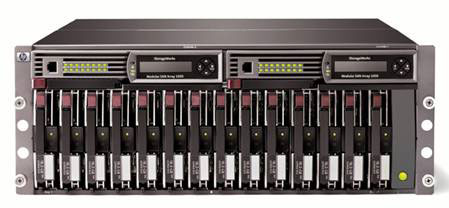
Figure 3: Observe the RAID array (outside)
RAID has several levels. You can configure RAID in many ways. Table 1 lists a general chart for using RAID levels and tolerance for errors.
RAID Type Level Error Correction Capacity Number of disks required to execute RAID 0 Mirroring Yes 2 RAID 1 Duplexing Yes 2 RAID 0 + 1 Mirroring + Duplexing Yes 2 RAID 3 Striping without Parity No 2 RAID 5 Striping with Parity Yes 3+Table 1: RAID levels
Although there are many different RAID levels, they are all commonly used today. You can also mix and compare RAID levels together based on how to create the partition. You must know the available levels and what to use when deploying.
Once you have chosen the enterprise-level hardware you want to use, make sure that there are adequate drivers and software necessary for deployment. Windows Server 2008 is completely new as mentioned earlier, maybe you will not get full driver support or in some cases, for example, the management software used for the server may not run on Windows Server 2008. Because of this, you need to go to the Microsoft website to check the current drivers and software, then check the vendors' websites for updates they have. In any case, you would be better off creating a smart installation plan, collecting all the software and drivers needed for the installation.
System requirements
When deploying Windows Server 2008, you need to consider and adhere to the minimum requirements required for the system. If you do not meet these minimum requirements, your installation will not proceed. Table 2 introduces a list of the minimum and maximum requirements of this operating system.
Table 2: System requirements for Windows Server 2008
When sizeing settings, you should consider the pre-planning already discussed. If there is a list showing the processing resources of the combined applications on the server that will be deployed, you may find it necessary to add the CPU source or increase it a bit. You may be cluttered between supplies for dual core CPUs. You should note that CPU performance depends only on the processor clock frequency, but also on the number of processor cores and the size of the cache. Intel Itanium 2 processor is required for Windows Server 2008 for Itanium systems as an example. Now that you know what you need, let's start deploying Windows Server 2008.
Hardware configuration
To install Windows Server 2008 properly, you must configure the hardware first. When working with enterprise server systems such as the HP DL380, for example, you will need to configure your storage correctly so that you can install Windows Server 2008 within the required hard disk space requirements. To do that, you need to configure RAID. To configure RAID, you must use your server BIOS, or the management utility included in it. In this example, we will use the system BIOS.
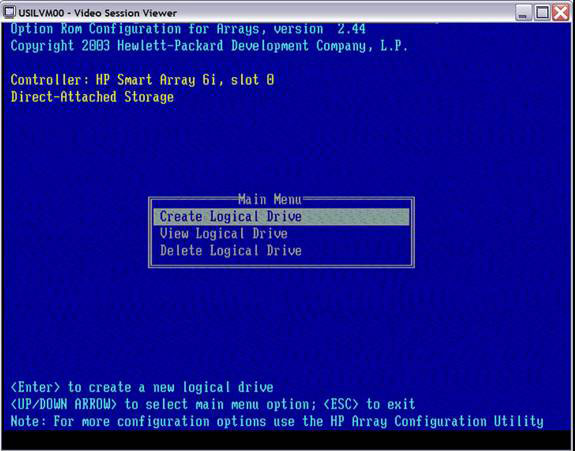
Figure 4: Configuring RAID array
As mentioned in the previous section, you have multiple RAID levels that exist on the same server. Figure 5 shows the HP DL380 BIOS configuration being prepared to install Windows Server 2008. Here in this example we will configure the HP Smart Array 6i, which comes with its own controller. or HBA (Host Bus Adapter). In Figure 5 you can configure backup drives.

Figure 5: Configuring logical arrays in Array
When RAID is configured and installed, you can install Windows Server 2008 on this prepared hardware.
Note :
Always use RAID if possible. In the previous example, the drives were configured so that when the hardware or system crashed, it would be fixed using RAID. For the previous example, the disks on which the operating system is installed are mirrored in the RAID 0 + 1 configuration. The maintenance disks are configured to support RAID 5. In this type of configuration, you can avoid disasters by performing backup backup of the system drive and backing up data on the second RAID configuration. In the BIOS, it represents two logical drives (about 70GB of space) and the second drive with 200GB of space. You can now install Windows.
Install Windows Server 2008
Implementing Windows Server 2008 is really easy. Once you have all the prerequisites and planning in advance, all you need at the moment is to run the installation program. The recommended list will show you the direction for the drives or software that are ready for installation. You should view and check the status of the drives before the installation process starts.
When installing Windows Server 2008, you will see the installation work through multiple layers:
1. First, you must insert the disc into the installation device (if installed from CD / DVD-ROM) and then run the auto-install installation program that does not automatically install. Figure 6 shows the initial dialog box for installing Windows Server 2008. Click Next and begin the installation process. When selecting 'Install Now', you will get a configuration option and enter the activation key.
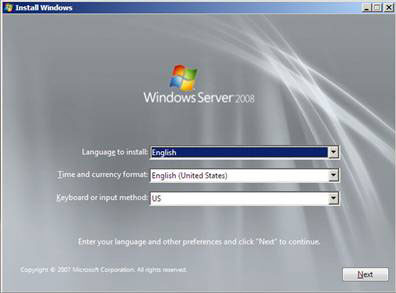
Figure 6: Installing Windows Server 2008
2. Next, enter the activation key and click Next. If you do not have an activation key, you will not be able to use Windows Server 2008.
3. Once you have entered the activation key, you will have a choice about the installation type. Figure 7 shows that you can choose the complete installation (the installation we made here), or Server Core (only install basic services and necessary functions). The two options here are:
- Windows Server 2008 (Full Installation): This option installs all Windows Server 2008. It includes the user interface and supports all server roles.
- Windows Server 2008 (Server Core Installation): This option installs a minimum of necessary Windows Server 2008 services, which you can use to run supported server roles through the command prompt interface.

Figure 7: Select Full Installation or Server Core
4. Next, agree to the registry entry and click Next to continue. If you do not agree, you will not be able to install Windows Server 2008.
5. Next, you can agree to install, or if the installation program detects some Windows installation it will ask you to choose a custom upgrade or installation to perform a completely new Windows installation. Server 2008 on the system.
6. Next you configure the drive options. If you select 'Advanced', you can configure specific drives and patitions, besides how you want Windows to layout the system on the drives.
Note :
You must ensure that when you select the option to perform the upgrade, the machine must already have a server operating system. With Windows Server 2008 now released to manufacturers, one aspect of the transition process for this new server platform is related to upgrade paths from Windows Server 2003, the operating system that almost all customers currently in use. If you are using Windows Server 2003 in your business and using 2003 based on ADS, DNS and DHCP, . it will be a 'best' candidate for an upgrade.
Microsoft has advised that if you do not run an 'ideal' or 'optimal' scenario, you should perform a completely new installation script. In this case, you will have to backup all your production data, install (upgrade) to Windows Server 2008, test and then add data and make sure everything runs correctly and as expected. . As mentioned earlier in this article, you should test all software, drivers and firmware, as well as applications and programs before installing or upgrading to Windows Server 2008. This is to say, if you If you perform an upgrade (or a new installation), you will know how your applications work and will not cause problems when moving into a production environment.
7. Now the files will be installed on the system and the installation will start.
8. When the installation is completed, you will be taken to the login screen and use Windows Server 2008 for the first time as shown in Figure 8.
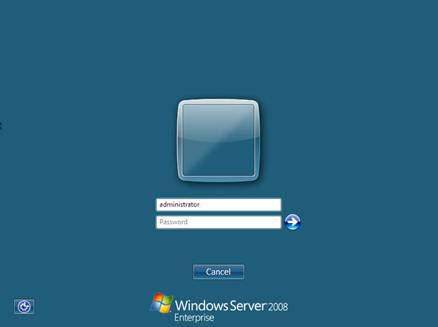
Figure 8: The screen is logged into Windows Server 2008 for the first time
Now that you have a complete Windows Server 2008 installation on the enterprise class hardware and put into the production environment . You should check your system logs and make sure you do and practically every things are working as expected. It also helps create a new boundary for the system and see how it works when there are no downloads, downloads and then performs scheduled or periodic checks when you continue using the system. system to make sure it works as expected.
Install Server Core mode
Although the focus of this article does not introduce Server Core installation, however, we will mention a few as well as the links provided to get extended information if necessary. When installing Server Core for Windows Server 2008 x86 and x64 server names, you will be prompted during the installation process to install a minimum set of requirements for dark basic and security functions. Best. This option installs a minimal server for Windows Server 2008, you can use it to run supported server roles through the command prompt interface and exactly what it is when you ask.
When you select this option, Setup will install the required files for the selected server roles just to perform certain functions.
For example, the GUI we all know as a windows interface will not be installed here - you must configure and manage the internal server from the command prompt and there will be no option to work within the GUI. because simple GUI does not exist in this installation mode. You should consider this option because it will reduce the management and service requirements and attack surface of the system.
Note :
There are many other installation methods here. You can run Server Core installation with a minimum functionality, unintended settings and multiple installations simultaneously. No matter which installation method you choose, you still have to spend time before developing pre-installation steps, designs and other lists to help you deploy the system most easily. .
Once you have installed and configured Windows Server 2008, you may encounter some problems. To solve these problems, use notes about the problem (error codes, instruction screens and alert notifications) that appear and search online, in books or recreate a system. system in non-production laboratory.
Fix installation problems
When installing Windows Server 2008, you may encounter some problems. As mentioned earlier, if you do not get updated drivers from vendors or system and service providers, you will experience installation problems with the system. Even if you have everything you believe is necessary, you can still encounter these problems. Some unforeseen problems that can happen suddenly are in the following list:
1. Drivers, software, hardware and firmware are not supported, buggy or unusable (applications, programs) and lack of vendor upgrades and patches.
2. File systems are not supported like FAT
3. Loss of power when installing - if on the network, lose connection while running the installation.
4. The installation disc may fail if using DVD-ROM. Sometimes installing an ISO for the installation disc, the burn speed (if too high) can cause disk problems.
5. The error messages that you cannot decrypt need to be searched on the Microsoft support page and other information.
Note :
If you encounter these problems in the upgrade installation mode, follow the following upgrade path posted by Microsoft:
- Windows Server 2003 Standard Edition users (R2, SP1 or SP2) can perform a complete installation of Windows Server 2008 Standard Edition or Enterprise Edition.
- Windows Server 2003 Enterprise Edition (R2, SP1 or SP2) can be upgraded to a complete installation of Windows Server 2008 Enterprise Edition
- Windows Server 2003 Datacenter Edition (R2, SP1 or SP2), can upgrade to a complete installation of Windows Server 2008 Datacenter Edition.
Conclude
In this article, we have introduced the basic concepts of installing Windows Server 2008 in enterprise-class servers and hardware such as initial preparation, deployment steps, and caveats for consideration. The article also introduces the basics of installing Windows Server 2008 (complete installation) on hardware, RAID configuration and ensuring the installation is carried out smoothly.
You should read it
- Microsoft stopped supporting SQL Server 2008 and Windows Server 2008
- Windows Server 2008 cleans the path for 64-bit
- Microsoft rushed to release security updates for Windows XP, Server 2003
- Configure Windows Server 2008 to remotely access SSL VPN Server (Part 3)
- Application security with AppLocker
- Managing printers in Windows Server 2008 - Part 1
- Install Hyper-V Virtualization on Windows Server 2008 R2
- How to Install Windows Server 2008
May be interested
- Instructions for installing Windows Server 2012 step by step
 in this windows server 2012 tutorial, we will learn about system requirements and how to install windows server 2012. invite you to follow up.
in this windows server 2012 tutorial, we will learn about system requirements and how to install windows server 2012. invite you to follow up. - Use IIS to set up FTP Server on Windows
 set up an ftp server (file transfer protocol server) to share and convert large files with unlimited traffic.
set up an ftp server (file transfer protocol server) to share and convert large files with unlimited traffic. - How to set up a local web server (Local Web Server) on Windows, macOS, and Linux
 when developing your own website, you need to have the ability to observe and evaluate what the website might look like from a regular visitor's perspective. here are the steps for setting up a local web server on windows, mac and linux
when developing your own website, you need to have the ability to observe and evaluate what the website might look like from a regular visitor's perspective. here are the steps for setting up a local web server on windows, mac and linux - Install DNS server and Domain Controller in Windows Server 2003
 dns configuration is similar to installing it, which means you don't need to be too bothered or ask any administrator to help you do that, because you can do this yourself.
dns configuration is similar to installing it, which means you don't need to be too bothered or ask any administrator to help you do that, because you can do this yourself. - How to initial setup Windows Server 2019
 after downloading and installing windows server 2019, you will go to the initial setup process. let's find out details through the following article!
after downloading and installing windows server 2019, you will go to the initial setup process. let's find out details through the following article! - 6 ways to access Control Panel on Windows Server 2012
 windows provides a range of tools on the control panel so users can easily customize most settings. unlike other windows versions, windows server 2012 interface has some new features so when you access applications, installing on windows server 2012 will be different than previous windows versions.
windows provides a range of tools on the control panel so users can easily customize most settings. unlike other windows versions, windows server 2012 interface has some new features so when you access applications, installing on windows server 2012 will be different than previous windows versions. - Steps to bypass TPM 2.0 requirement when installing Windows 11
 on windows 11, microsoft requires the computer to have the tpm 2.0 feature. without tpm 2.0, or not activated, you will not be able to install windows 11.
on windows 11, microsoft requires the computer to have the tpm 2.0 feature. without tpm 2.0, or not activated, you will not be able to install windows 11. - How to create DC Accounts in Windows Server 2012
 in windows 2012, creating ou and group accounts is almost the same as in previous versions.
in windows 2012, creating ou and group accounts is almost the same as in previous versions. - How to install Caliber Content Server on Raspberry Pi
 caliber is a great piece of software for managing your ebook collection. in today's article, tipsmake will guide you how to install caliber content server on the raspberry pi.
caliber is a great piece of software for managing your ebook collection. in today's article, tipsmake will guide you how to install caliber content server on the raspberry pi. - 4 basic difference between Windows Server and Windows Desktop
 windows server is the operating system for servers, servers, so it will have differences compared to the windows desktop version we still see everyday. keep these in mind when you need to choose to install windows server or windows desktop. they are also important when you need to restore, repair installation.
windows server is the operating system for servers, servers, so it will have differences compared to the windows desktop version we still see everyday. keep these in mind when you need to choose to install windows server or windows desktop. they are also important when you need to restore, repair installation.










 IIS 7.0 - FTP Publishing Service - Part 1: Installation
IIS 7.0 - FTP Publishing Service - Part 1: Installation IIS 7.0 - FTP Publishing Service - Part 2: Configuration
IIS 7.0 - FTP Publishing Service - Part 2: Configuration IIS 7.0 - FTP Publishing Service - Part 3: Security for an FTP site
IIS 7.0 - FTP Publishing Service - Part 3: Security for an FTP site Install Windows Server 2008
Install Windows Server 2008